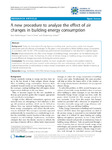A new procedure to analyze the effect of air changes in building energy consumption

Use this link to cite
http://hdl.handle.net/2183/36721
Except where otherwise noted, this item's license is described as Creative Commons Attribution 2.0 International License (https://creativecommons.org/licenses/by/2.0)
Collections
Metadata
Show full item recordTitle
A new procedure to analyze the effect of air changes in building energy consumptionDate
2014Citation
Barkhudaryan, N., Orosa, J.A. & Roshan, G. A new procedure to analyze the effect of air changes in building energy consumption. J Environ Health Sci Engineer 12, 37 (2014). https://doi.org/10.1186/2052-336X-12-37
Abstract
[Abstract] Background: Today, the International Energy Agency is working under good practice guides that integrate appropriate and cost effective technologies. In this paper a new procedure to define building energy consumption in accordance with the ISO 13790 standard was performed and tested based on real data from a Spanish region.
Results: Results showed that the effect of air changes on building energy consumption can be defined using the Weibull peak function model. Furthermore, the effect of climate change on building energy consumption under several different air changes was nearly nil during the summer season.
Conclusions: The procedure obtained could be the much sought-after solution to the problem stated by researchers in the past and future research works relating to this new methodology could help us define the optimal improvement in real buildings to reduce energy consumption, and its related carbon dioxide emissions, at minimal economical cost.
Keywords
Energy
Ventilation
ISO13790
Climate change
Monte Carlo
Ventilation
ISO13790
Climate change
Monte Carlo
Editor version
Rights
Creative Commons Attribution 2.0 International License (https://creativecommons.org/licenses/by/2.0)






